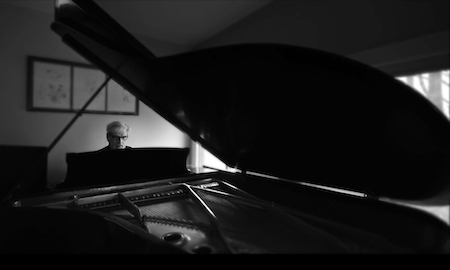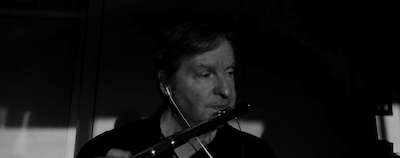by Jarrett Hoffman
Plenty of pre-recorded concerts have offered audiences some sort of new and compelling experience. But few organizations have mined that format with as much joy and silliness — and in general, personality — as Cleveland’s new music ensemble No Exit. That trend continues with their latest video, released on March 26 and centered around music by Cleveland-area composers.
You won’t want to miss the opening remarks, which turn the obligatory into a comedy routine. One of the best lines delivered by the shadowy head of artistic director Tim Beyer: “Recently, we’ve been flooded with letters from little boys and girls from around the country, all of them asking the same question: Tim, how can we give money to No Exit?”

Like those sections of the broadcast, the performances are also seen in grayscale, bringing a sense of cohesion and atmosphere to the separate recordings.

Throughout, Gunnar Owen Hirthe makes magic with his gentle articulations and smooth decays. He times the tremolos rewardingly, and his unobtrusive circular breathing keeps the long phrases smooth and the tension taut.
As both composer and performer, Nicholas Underhill explores a fascinating partnership in the two-movement Concerto for Piano and MIDI Orchestra. The abbreviation “MIDI” (Musical Instrument Digital Interface) might conjure something cheap-sounding in your head, but these samples — from a pipe organ to steel drums to the sound of a helicopter — are aurally pleasing, and blend intriguingly with piano. Sometimes those two sources of sound whirl together. Other times, one or the other leads the way, or even takes a solo passage.

But what stands out most is the arc of this piece: it gradually and convincingly progresses, but also returns now and then to its opening material, providing a satisfying sense of destination and origin. The only oddity is the camera angle — it might feel more comfortable to rotate your device 90 degrees.
In Beyer’s Amputate II (2007), the only non-premiere of the broadcast, the composer sets a mournful, meditative atmosphere with the alto flute, then allows bits of electronic sound to make their way in almost intrusively, like bad memories. Eventually, those sounds bear down upon you, before the purity of long tones brings things to a close.
Of special mention are Sean Gabriel’s virtuosic air control, and the instrumentation itself. Both the general mellowness of the alto flute and the discomfort of its high range provide the exact pairing needed for this music.
The finale, Ezekiel Paulowski’s 2020 Set to Viola: What We Will Remember, shines with its original language, bringing in elements of Romanticism but casting them in a cold, subdued light. Near the end, Paulowski takes the piece in a different direction, introducing bits of Stars and Stripes Forever. Some moments in this section feel a little on the nose, while others incorporate that music quite convincingly. Throughout, James Rhodes impresses with his clean technique and his keen, confident expression — not at all over-Romanticized — expertly putting across this unique take on recent events.
Published on ClevelandClassical.com March 30, 2021.
Click here for a printable copy of this article







